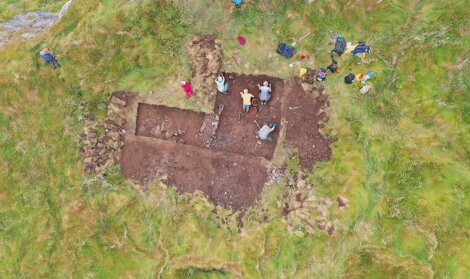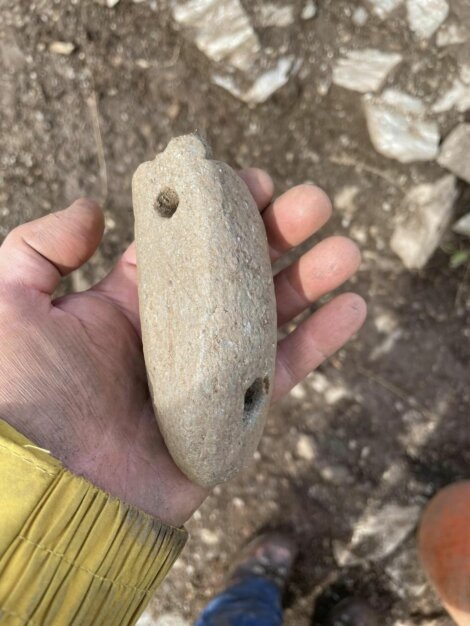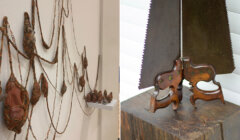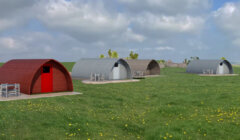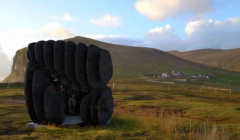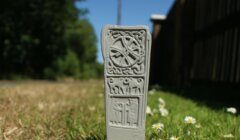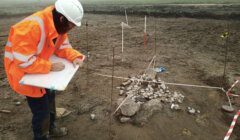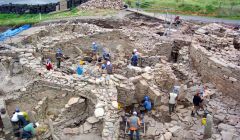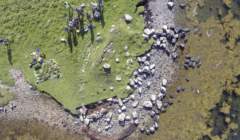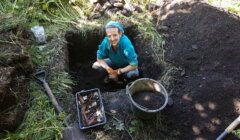History / Archaeological dig finds Pictish or Viking tools at settlement in North Mainland
ARCHAEOLOGISTS have spent the last week excavating one of Shetland’s most challenging sites at the Kame of Isbister near North Roe.
The Kame is a rocky headland 38 metres high only accessible by ropes. Professional climber Liam Malone has been on hand to assist with access along the precarious path to the site.
The dig has been initiated by Dr Andrew Jennings and Dr Simon Clarke of the University of the Highlands and Islands (UHI) and led by professor Gordon Noble of Aberdeen University as part of his Northern Picts project.
Local volunteers have been helping too, with one finding an iron angle backed knife in the settlement, common in both Viking and Pictish settlements.
Noble held a talk at Islesburgh Community Centre on Thursday hosted by Archaeology Shetland and presented findings from the site to a packed audience of more than 60 people.
He explained many sites in Shetland show artefacts from the 10th century, such as Jarlshof and Old Scatness, but the aim is to look for new sites that tell us more about Vikings and the Picts.
A previous excavation in 2003 for Channel 4 TV show Extreme Archaeology offered carbon dating at the Kame to the 8th century, drawing Noble’s interest as part of his project.
The team began on Monday (5 August) by opening a trench across two houses on the Kame. Noble added that finds have been ‘thin on the ground’, and the excavations have shown the site may have only been used temporarily, or seasonally, based on the quality of the walls.
Become a member of Shetland News
He said: “They seem to have been put together quickly so it doesn’t indicate long-term occupation.”
Another theory could be that the site was used for an economic purpose like fishing or was a place that was originally intended as a permanent settlement but was abandoned quickly.
Previously, the site has been interpreted as monastic.
Noble stressed the need to investigate sites like the Kame of Isbister now, before it’s lost altogether, saying: “Access to the Kame is getting harder and harder, it’s pressing to do before it all falls into the sea.”
He added: “It’s interesting to think about how much we’ve lost over the years, the stack could have once been much bigger.”
The Kame of Isbister was first excavated in 1876 where approximately 23 buildings were recorded and hearths identified.
A further excavation was planned in 1970 but access to the Kame was no longer possible due to coastal erosion preventing a clear path from the mainland so aerial photographs were taken instead which showed around 20 buildings.
Noble also identified another site of interest in Shetland down at Mail in Cunningsburgh also being exposed due to coastal erosion where previous Pictish artefacts have been recovered.
Conquering the Kame of Isbister:
Become a member of Shetland News
Shetland News is asking its many readers to consider paying for membership to get additional features and services: -
- Remove non-local ads;
- Bookmark posts to read later;
- Exclusive curated weekly newsletter;
- Hide membership messages;
- Comments open for discussion.
If you appreciate what we do and feel strongly about impartial local journalism, then please become a member of Shetland News by either making a single payment, or setting up a monthly, quarterly or yearly subscription.






